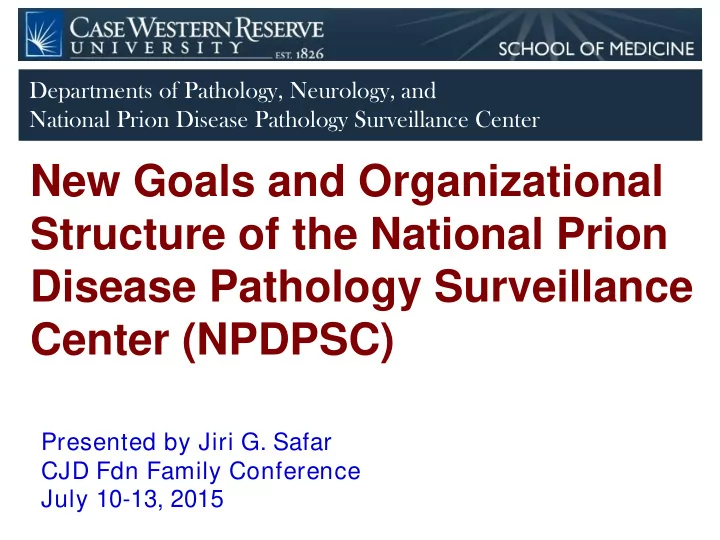

Departments of Pathology, Neurology, and National Prion Disease Pathology Surveillance Center New Goals and Organizational Structure of the National Prion Disease Pathology Surveillance Center (NPDPSC) Presented by Jiri G. Safar CJD Fdn Family Conference July 10-13, 2015
Human prion diseases are invariably fatal brain disorders Manifestation Diseases (Frequency) 1. Sporadic Creutzfeldt-Jakob disease (CJD); age-adjusted (90%) incidence is 4-6 cases/million in age 65-79 worldwide; prevalence ~200-300/million 2. Inherited Familial CJD, Gerstmann-Sträussler-Scheinker (10%) disease, and fatal familial insomnia 3. Infectious Kuru among New Guinea natives transmitted (<1%) by cannibalism Iatrogenic CJD caused by growth hormone derived from human pituitaries, dura mater and cornea transplants New variant CJD caused by BSE prions from contaminated beef
Reservoirs of zoonotic and iatrogenic prion pathogens iatrogenic iatrogenic (hospital) (hospital) Variant Creutzfeldt-Jakob Creutzfeldt-Jakob iatrogenic CJD Disease (CJD) Disease (CJD) zoonotic scrapie Chronic BSE (“Mad Cow Wasting Disease”) Disease (CWD )
Imperative goals of National Prion Disease Pathology Surveillance Center (NPDPSC) • Detection and characterization of vCJD and other human prion diseases caused by zoonotic or hospital transmissions, or new prion types (strains) • Monitoring changes in the incidence and prevalence of human prion disease and identification of epidemiological foci • Monitoring spectrum of human prions • Development and validation of rapid presymptomatic tests for human prions • NPDPSC is the only reference laboratory for human prion diseases in the US providing training and consultation • Genetic screening, counseling for hereditary forms of prion diseases • Public education and outreach in partnership with CJD Foundation
CENTERS FOR DISEASE CONTROL AND PREVENTION (CDC) IN PARTNERSHIP WITH CASE WESTERN RESERVE UNIVERSITY NATIONAL PRION DISEASE PATHOLOGY SURVEILLANCE CENTER MANDATES AND PROGRAMS Autopsy & diagnostic Detection of genetic prion neuropathology diseases Molecular typing of human Surveillance of human prion prions diseases Epidemiology of human prion Case reports and publications diseases Development and validation of Clinical and laboratory new methods for prion diagnostics – CSF, blood, urine diagnostics and differentiation
NEW STRUCTURE OF NATIONAL PRION DISEASE PATHOLOGY SURVEILLANCE CENTER Director: Jiri G. Safar, Scientific Leadership and General Oversight Co-Directors: Mark Cohen, Clinical Neuropathology Brian Appleby, Clinical Diagnostics Clive Hamlin, Laboratory Diagnostics Associate Director: Wenquan Zou, Prion Strain Typing Other Program Faculty: Marta Couce, Neuropathology Shulin Zhang, Genetics Pierluigi Gambetti, Neuropathology Advisory Board: Debbie Yobs, President, Florence Kranitz, Past Chair - Cliff Harding, Chair of Pathology President of Creutzfeldt-Jakob Disease Fdn Anthony Furlan, Chair of Neurology Bernardino Ghetti, Distinguished Professor, Jonathan Haines, Chair of Epidemiology Indiana University School of Medicine & Biostatistics James Ironside, UK CJD Surveillance Unit, Mark Chance, Vice Dean for Research University of Edinburgh, United Kingdom REPOSITORIES Frozen AND DATABASE tissues, CSF, & Urine Blood & Fixed Olphactory tissues epithelium Database
National Prion Disease Pathology Surveillance Center Cases Examined 1 (April 10, 2015) Total Year Prion Disease Sporadic Familial Iatrogenic vCJD Referrals 2 1996 & earlier 54 35 31 4 0 0 1997 111 66 57 9 0 0 1998 87 51 43 7 1 0 1999 121 73 65 7 1 0 2000 141 99 87 12 0 0 2001 210 118 110 8 0 0 2002 243 145 126 17 2 0 2003 256 158 137 21 0 0 1 3 2004 317 182 164 17 0 2005 328 179 157 21 1 0 2 4 2006 370 183 164 17 0 2007 367 203 184 19 0 0 2008 388 224 208 16 0 0 2009 400 234 213 20 1 0 2010 402 246 217 29 0 0 2011 393 239 216 23 0 0 2012 409 241 218 23 0 0 2013 417 258 223 34 1 0 1 5 2014 353 209 185 22 0 2015 92 59 42 4 0 0 TOTAL 5459 6 3202 7 2847 330 8 7 4 1 Listed based on the year of death or, if not available, on year of referral; 2 Cases with suspected prion disease for which brain tissue was submitted; 3 Disease acquired in the United Kingdom; 4 Disease acquired in the United Kingdom in one case and in Saudi Arabia in the other; 5 Disease possibly acquired in a Middle Eastern or Eastern European country; 6 Includes 9 cases in which the diagnosis is pending, and 19 inconclusive cases; 7 Includes 14 (13 from 2015) cases with type determination pending in which the diagnosis of vCJD has been excluded. The sporadic cases include 3127 cases of sporadic Creutzfeldt-Jakob disease (sCJD), 54 cases of Variably Protease-Sensitive Prionopathy (VPSPr) and 21 cases of sporadic Fatal Insomnia (sFI). 8 Excludes positive blood tests for pathogenic PRNP mutations on 191 persons for whom no brain tissue was submitted, including primarily the living family members of prion disease patients. Rev 5/19/2015
Analytical sensitivity of second generation RT QuIC
Diagnosis of sCJD using cerebrospinal fluid (CSF) and second generation RT QuIC
Future plans and goals • Optimization and validation of next generation – ultrasensitive tests for human prions (RT QuIC diagnostics) • Development of new strategies for rapid postmortem and early antemortem diagnostics of human prion diseases to prevent iatrogenic (hospital) transmissions • Development of new approaches for rapid antemortem and postmortem differentiation of human prions to identify their origin – iatrogenic, zoonotic, or genetic • Upgrading operating structure and standards of National Prion Center – biobank, database, clinical data collection • Improving and updating the outreach program techniques in partnership with CJD Foundation and medical associations
Recommend
More recommend